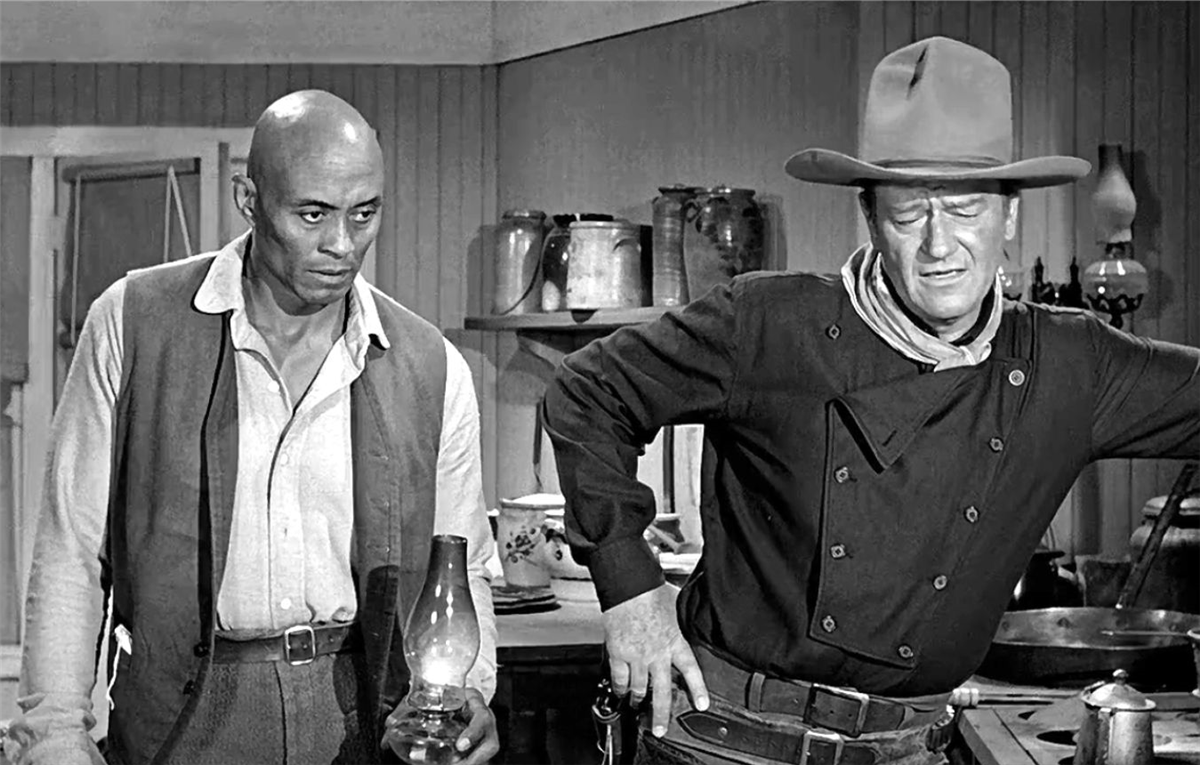The Man who shot Liberty Valance (1962) was the last western John Ford made with John Wayne. The film, also starring James Stewart, Lee Marvin and Vera Miles, is Ford’s most political film that subverts a lot of myths about the American West as well as the John Wayne persona that Ford himself created
“This is the West, sir. When the legend becomes fact, print the legend.”
With that one line of dialogue, John Ford pretty much dismantles the entire mythology of the American west that he had created over a course of 40 years. This famous aphorism (One of the most famous lines in Movie history) is spoken by the character of a newspaperman in Ford’s 1962 western, The Man who shot Liberty Valance. The naïve myths and legends (or untruths) that Ford had propagated about the civilizing of the West (and the building of the American nation), through the 70 odd films he made in his lifetime are all overturned by him in this film. This is also the last western he would make with his most favorite actor John Wayne, with whom he did close to 14 films. From the time Ford first teamed up with Wayne in Stagecoach in 1939, Wayne’s towering persona was Ford’s chief instrument in conceiving and propagating the myths about the old west. While Howard Hawks’ westerns emphasized professionalism and comradeship among the settlers of the old west, and Anthony Mann’s westerns shed light on the dark side of this civilization: greed, vengeance and violence; the westerns that John Ford made were not just simple genre pictures, they were about the building of the American nation. His films appeared very simple and, at times, very simplistic, but they dealt with huge themes: the expansion of American military might, the conflict between the European settlers and native American civilizations, the establishment of law & order in the wilderness, and the coming of religion, trade and commerce; all these themes are reflected in one way or the other in all his westerns. His westerns were all optimistic in nature and concentrated on building a myth, rather than showing the gritty reality. His films begins on an optimistic note and ends on an optimistic note; even if the they would detour into darker, pessimistic territory in between, his films always end on a note of hope and glory. Take Fort Apache (1948) for instance, which is a strong polemic on American military intervention against the Native Americans. The film ends with the defeat of American cavalry and the pathetic death of Col. Thursday (Henry Fonda). But the very final scene of the film had John Wayne extolling the virtues of the American soldier, and in the background, the Cavalry is seen riding out take on the Indians. Ford turns the ending into a rousing beginning and constructs an elaborate mythology for the American military. Ford’s westerns portrayed truth, honor, courage, family and community as the chief weapons by which the American West was won. But as he would come to reveal in Liberty Valance, he was just printing the legend all along, leaving out the hard facts.
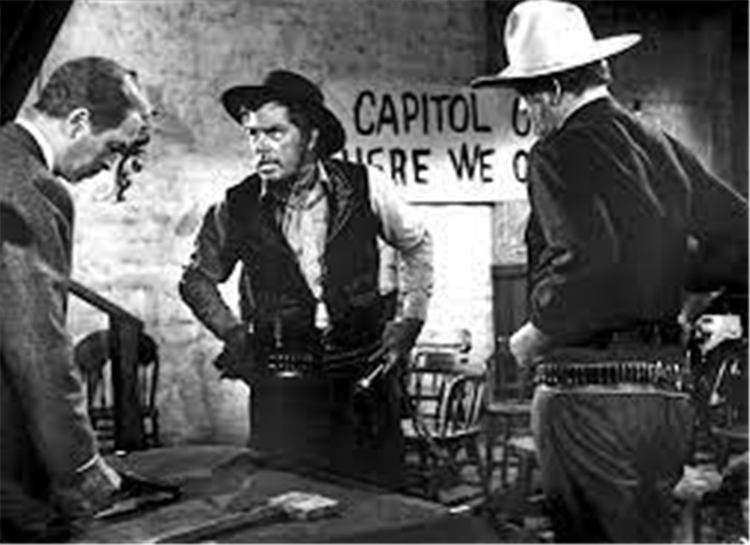
In its tone, structure and visual style, the film is very different from other John Ford Westerns. Ford uses a flashback structure to tell the story; Ford’s films are usually very linear, and he seldom uses a scattered narrative. It is also his most claustrophobic western; shot in Black & White and completely on a studio lot with minimal sets, the film has none of his trademark shots of stunning landscapes and colorful panoramic vistas. But the most important of all, the film begins with the death of his lead character, Tom Doniphon, played by none other than John Wayne. By putting John Wayne in a coffin right at the beginning of the film, Ford makes his intentions very clear. He is putting to death all that Wayne represented in his westerns up until that time and for the rest of the film, he is going to painfully reconstruct the mythology of the west and Wayne through some cold hard facts. The story takes place in a fictitious town of Shinbone in an unnamed Western territory (probably Colorado). As the film opens, U. S. Senator Ransom Stoddard (James Stewart) is arriving in Shinbone by the new railroad with his wife Hallie (Vera Miles). There are here to attend the funeral of a man named Tom Doniphon (John Wayne). Doniphon is not a person of any importance around town, just a sorry old man on the fringes, who passed away unnoticed. So the newspapermen are all surprised, as to why Ranse Stoddard: three-term governor, two-term senator, ambassador to the Court of St. James, would attend his funeral. And as they swarm around the senator for details, Stoddard starts recalling the events leading up to that day and, the film cuts to a flashback.
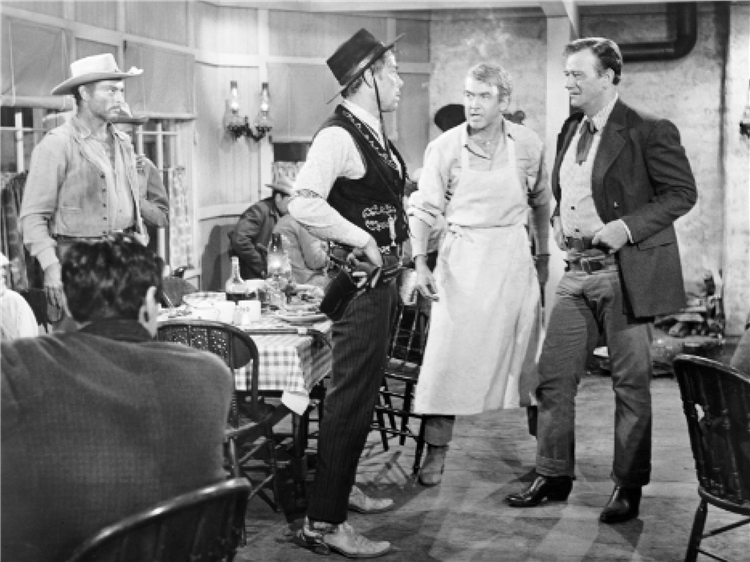
25 Years ago, Shinbone was held in a grip of terror by the sadistic Liberty Valance (Lee Marvin), who committed many murders and enjoyed torturing his victims using a leather bullwhip. When Stoddard arrived in town by stagecoach, he was a fresh young lawyer with some romantic notions about bringing law & order to the west. But right on his arrival, he encounters the brutal Valance, who steals all his belongings and almost whips him to death. Stoddard is saved by Doniphon, a local farmer and horse trader, who observes: “Liberty Valance’s the toughest man south of the Picketwire–next to me.” Stoddard is nursed back to health by Hallie (Vera Miles). Valance and his two henchmen terrorize Shinbone, while the bumbling Marshal Link Appleyard (Andy Devine ) lacks the courage and gun fighting skills to challenge him. Doniphon (who is courting Hallie) is the only man willing to stand up to Valance. But he is a sort of reluctant hero, who minds his own business, and is roused into action only if his path crosses with the outlaws. Stoddard continues to defy Valance and earns the respect of the townsfolk, by first opening a law practice in town and then starting a school for teaching illiterate townspeople. This leads to Stoddard being elected as a delegate (along with Dutton Peabody (Edmond O’Brien), publisher of the local newspaper) for a statehood convention at the territorial capital. But the plans of statehood for the territory upset the cattle barons, who recruit Liberty Valance to sabotage the delegation. Valance and his gang beat up a drunken Peabody nearly to death, and ransack his office. He then throws down a challenge to Stoddard: leave town or face him in a gunfight. Earlier, we have seen Doniphon training Stoddard in the use of guns, but finding Stoddard not up to the task, Doniphon had humiliated him. Now Stoddard accepts Valance’s challenge (ignoring Doniphon’s advice to leave town) to shoot it out with him. Stoddard goes into the street to face Valance. Valance toys with Stoddard, shooting his arm and laughing at him. The next bullet, he says, will be “right between the eyes”; but Stoddard fires first, and to everyone’s surprise, Valance falls dead. Hallie attends to Stoddard’s wounds and it appears to Doniphon that she has fallen in love with Stoddard. A dejected Doniphon, who was hoping to marry Hallie and move into his new house, gets drunk and burns down his house. His friend & Ranch hand Pompey (Woody Strode) saves him from the fire, but is unable to save the house. With Valance’s death, the road is clear for Stoddard to become the delegate to Washington and with Doniphon out of the way, he can also marry Hallie. But things are not that easy. Stoddard decides that he cannot be entrusted with public service after killing a man in a gunfight and he decides to withdraw. Here again Doniphon comes to his rescue. Doniphon takes Stoddard aside, and in a flashback within a flashback, confides that he, Doniphon, actually killed Valance from an alley across the street, firing at the same time as Stoddard. Now with his conscious clear, Stoddard returns to the convention, accepts the nomination, and is elected to the Washington delegation. The film flashes forward to the present, where Stoddard sums up the rest of his story. The territory is granted statehood and, being the man who shot Liberty Valance, Stoddard became its first governor. From thereon, he goes onto even more heights in his political career, and now he is expecting a nomination to be the vice-president of the country. He had married Hallie in the interim, and now, they have come to pay their final respects to ‘The ‘real’ Man who shot Liberty Valance. After hearing all this, the newsmen decide not to print the story, as the mythology that propelled Stoddard has to be protected at any cost.
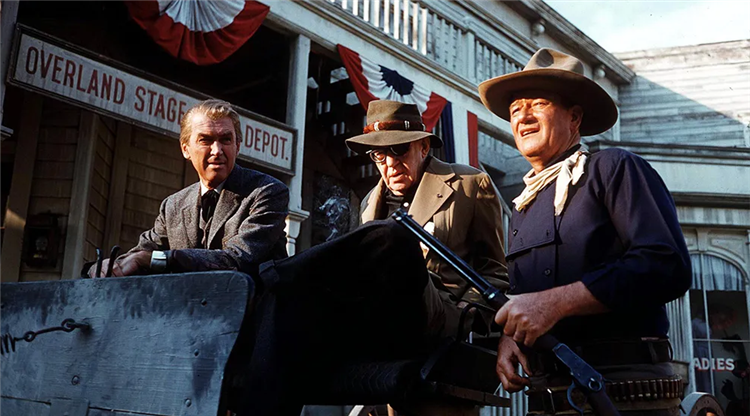
Director John Ford has been a pioneer, not only of the Western genre, but also the art form of cinema itself; he is an inspiration to some of the greatest filmmakers all around the world; Akira Kurosawa, Orson Welles, David Lean,.. Have all expressed their admiration and debt to Ford in developing their own cinematic technique. Rarely do we find the influence of other directors in Ford’s movies. But in Liberty Valance (as well as in his previous film Sergeant Rutledge) I find a strong influence of Kurosawa’s Rashomon; especially, dealing with the exploration of a particular event (involving a crime) from multiple vantage points. Also, the rumination on the differences between truth and fact was at the heart of Kurosawa’s classic. It’s much more explicit in Sergeant Rutledge, which transposes the incident involving rape and murder in medieval Japan to the American frontier west. In this film, it is related to the killing of Liberty Valance, which is shown from two different perspectives. First from the subjective perspective of Stoddard, and then an objective version, depicting the fact; that it was Doniphon who killed Valance, and not Stoddard. Ford uses a flashback within a flashback technique to accomplish this, which is very unusual for him. He always liked his films to be clean and straight, and any form of alteration to the classical structure of the film was anathema to him. He also hated, what he called, intellectual snobbishness, but, this film is the most intellectual of all his films, not to mention cynical, political, pessimistic and subversive. As opposed to his other films, this film begins on a sad note, and as it goes on, it become more tragic and dark and finally ends on a very pessimistic note. At the time of the film’s release, it was dismissed as a minor work from a master filmmaker, but watching it now , it shows his extraordinary growth as a filmmaker, which is not just restricted to its thematic resonance, but also extends to its visual and narrative stylistics. In its sparseness and interplay of light and darkness, Ford evokes moments from Film Noirs- where Wayne comes out of the darkness, shoots Marvin, and then recedes back into darkness.
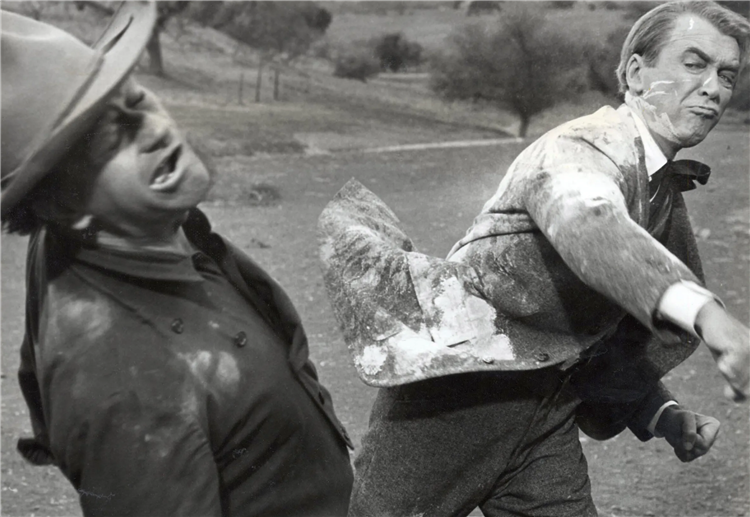
When John Ford and John Wayne set out to make this film, both of them were at a low stage in their life and career and, in their relationship with each other. After being one of Hollywood’s pre-eminent directors for more than three decades, Ford’s career was coming to an end. None of his recent films have been big hits, even the ones he made with John Wayne – like The Horse Soldiers– were failing to find favor with the audience. And after the flopping of “Sergeant Rutledge”, Ford found himself out of work. It was exacerbated by his failing health and his drinking problem, as the cantankerous Ford became even more of a misanthrope, thus alienating t he big studios from hiring him. Meanwhile, John Wayne was reeling from the financial setbacks caused by his dream project The Alamo

Wayne had every right to be pissed at the character he was assigned; Tom Doniphon is the most Anti-Johnwayne character that Wayne has ever played. Usually, when John Wayne fans count the number of films in which Wayne had died, they always miss out Liberty Valance, because he dies off-screen; but that only makes the character more insignificant; as opposed to films he died on screen, like Ride the whirlwind, The Alamo or The Cowboys, where Wayne always got a heroic death: he dies saving somebody else, or he dies for a greater cause. in Liberty Valance, he just slowly fades away from screen. He dies a drunkard, having lost everything in his life, unacknowledged and unknown. Wayne always plays characters who take charge of the situation, the guy who takes the fight to the opposition and, the contrast between him and the bad guy is always well defined. Here, Doniphon is a horse trader while the bad guy Valance is a stagecoach robber; within the framework of the film, both are from the same world and are pretty much allies; both are trapped in obsolescent careers, neither seems willing to adapt; they represent the best and worst of that old-world. Valance can be countered only by Doniphon, but Doniphon is a man too busy with his own affairs to want power or to impose his own beliefs on anybody else. This makes Doniphon a very passive character with respect to Valance, which explains why a direct confrontation never takes place between them, though at many points in the film, they come close. What Doniphon craves most is domesticity, but by finally shooting Valance, he loses that opportunity; this makes Doniphon the most tragic character that John Wayne has ever. In this sense, the ending is eerily similar to The Searchers, except there he walks back into the mythical wilderness that he came from, here he is just silently absorbed by history.

John Wayne would never play this character for anybody else, expect for his ‘pappy’ Ford. He always wanted to play her and he always looked at cinema as a medium for the audience to believe in heroes; there is the famous story where he chastised Kirk Douglas for playing a mad and tragic Van Gogh in Lust for Life. Wayne’s idea of himself always involved action and movement. Here, he is practically rendered motionless. Add to that the fact that he kills the villain, not face to face, but pretty much shooting him from the back- something that he abhorred and always criticized Clint Eastwood for doing. Another turn off was the fact that James Stewart’s Ransom Stoddard is the fulcrum of the plot and, for 99 percent of the picture, is also the man who shot Liberty Valance. But Stoddard is a powerless man; powerless before Valance; and powerless before Doniphon; and Doniphon lets Stoddard have his woman, his town, and his West. Wayne losing out to such a loser of a character would anger any john Wayne fan, most of all Wayne himself Wayne (and his audience) like to see Wayne triumphant, not as a tragic, moody alcoholic who dies off-screen. of course, Ford was making a larger point; that the kind of men needed to master the wilderness are the kind of men that can only function in wilderness; they are men who civilization must expel; If society is to benefit, then there is no place for either Valance or Doniphon in the new world.
There was lot of tension between Ford and Wayne during shooting. Ford started the film full of enthusiasm and fire, but he lost interest in the film almost as soon as shooting began. His mood made life difficult for all the actors involved but he was especially tough on Wayne, who found himself in the direct firing line again. Ford had pestered Wayne to take up the role, because without him there would be no film. Ford was very angry about it, having to secure a favor from his protégée and he doubled down on his venom on Wayne during the shooting. Wayne was furious for allowing himself to get roped in to play such a passive character, which he found very difficult to play, and Ford’s behavior didn’t help. When someone tried to comfort him that Doniphon was full of ambiguity and his mindset may help his performance, Wayne snapped back, “Screw ambiguity… I don’t like ambiguity. I don’t trust ambiguity.” Wayne became surly and aggressive during the shoot and he started taking out his anger on everybody else on the set, except Ford. His chief victim was Woody Strode, with whom he very nearly came to blows. Fortunately James Stewart, one of Wayne’s closest friends, was the other star of the picture, and he afforded Wayne some moments of light relief. But Wayne continued to bristle about the bad experience on making the picture, years later he recollected on his experience: “It was a tough assignment for me because dammit, Ford had Jimmy for the shit-kicking humor, O’Brien playing the sophisticated humor, and he had the heavy, Marvin. Christ there was no place for me. I just had to wander around in that son of a bitch and try and make a part for myself”. But the fact is that Wayne is really good as Tom Doniphon; Both he and Stewart, who were 54 and 53 respectability, were too old for the parts, but the film could not have been made without them. They were playing dual archetypes of the myth: the grizzled veteran cowboy and the idealistic, young, city-slicker lawyer. Wayne was America’s favorite cowboy, while Stewart, having graduated from the school of Frank Capra, with Mr. Smith Goes to Washington and It’s a wonderful life is its favorite idealist. The age factor was a bigger problem with Stewart, because he was playing a guy half his real age for most part of the film, but with Wayne, he was again playing a personality, a symbol which represents some abstract values, so it was not a problem for him. And he holds the center stage in a film, with his quiet dignity and powerful, charismatic presence, where everybody else, including Stewart, is giving highly exaggerated, even cartoonish performances. Of course, the pick of the lot was Lee Marvin who portrayed the anger, maliciousness, and sadism of a man who symbolized all the lawlessness of the old west, and who refused to step gently aside to encroaching civilization. Marvin enjoyed playing the larger-than-life ‘Liberty Valance,’ which he did to the hilt, opposite iconic costars like Wayne and Stewart. But he was frustrated with his costars’ leisurely pace,; he was a guy who moved fast , talked fast and worked fast. Marvin stole almost every scene in which he is featured. This was a breakout role for Marvin, who has been struggling in supporting parts and TV roles. After this film, his career would see a meteoric rise and, by the mid 1960’s, he would become one of the top stars in the industry. He also got along well with John Ford; Marvin was in the Navy in WWII, like Ford and they bonded over that. Ford would repeatedly use Marvin (and Stewart, who also served in WWII) as a stick to beat John Wayne, who hadn’t served in WWII, something that always offended Ford.
By the end of Liberty Valance, it was more than obvious that Ford and Wayne had come to the end of their long association, which started when Ford cast Wayne as an Odysseus like courageous hero in his western odyssey Stagecoach. From there to Liberty Valance, the character has now changed into a tragic hero, in the mold of Oedipus, who loses everything dear to him and wander off into the wilderness . There was nothing more for Ford to do with Wayne, at least in the western genre. They would make one more film together, the lighthearted comedy Donovan’s Reef (1963), and call it quits. Ford would make one more Western (without Wayne), Cheyenne Autumn (1964), the penultimate movie of his career which told the story of the Old-west from the perspective of the Native Americans. When Liberty Valance was finally released, it met with mixed critical reaction, the American critics didn’t think much of it, but the European critics called it one of Ford’s masterworks. The film, surprisingly for its downbeat nature, made money, at the box office, though not on the level of a John Wayne picture. The reputation of the film continues to grow over the years, and it was a big influence on Sergio Leone, who called this his most favorite Ford film. The film was a direct influence on Leone’s own ‘end of the west’ western Once upon a time in the West. John Ford died in 1973, and even though they didn’t make any more films together, John Wayne would remain close to his mentor till his death. Post-Liberty Valance, John Wayne would continued to be the most dependable American movie star of his times. He would also emerge victorious (at least temporarily) in his fight against cancer as well, and he would go on to enjoy more than a decade and half of solid superstardom, before he would finally succumb to cancer.
